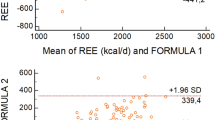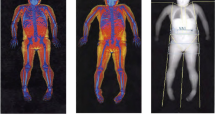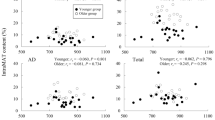Abstract
Objective: To investigate the relationship between resting energy expenditure (REE) and body composition in Duchenne Muscular Dystrophy (DMD).
Design: An observational study.
Setting: University Research Centre.
Subjects: Nine Duchenne children (age range 6–12 y), mean relative weight 128%, agreed to undergo the investigation and all of them completed the study;
Interventions: Assessment of body composition (total body fat and skeletal muscle mass) by magnetic resonance imaging and resting energy expenditure by indirect calorimetry.
Main outcome measures: Fat mass (FM; kg and percentage weight), fat-free mass (FFM; kg and percentage weight), muscle mass (kg and percentage weight), resting energy expenditure (kJ/kg body weight and kJ/kg fat-free mass).
Results: In Duchenne children fat mass averages 32% and total skeletal muscle mass 20% of body weight. Resting energy expenditure per kg of body weight falls within the normal range for children of the same age range, while when expressed per kg of FFM is significantly higher than reference values. No relationship was found between REE and total skeletal muscle mass.
Conclusions: Our results do not demonstrate a low REE in DMD boys; on the contrary REE per kg of FFM is higher than normal, probably due to the altered FFM composition. We suggest that the development of obesity in DMD children is not primarily due to a low REE but to other causes such as a reduction in physical activity and or overfeeding.
Sponsorship: Italian Telethon Foundation (grant no. 1137C, 1999).
This is a preview of subscription content, access via your institution
Access options
Subscribe to this journal
Receive 12 print issues and online access
$259.00 per year
only $21.58 per issue
Buy this article
- Purchase on Springer Link
- Instant access to full article PDF
Prices may be subject to local taxes which are calculated during checkout
Similar content being viewed by others
References
Blundell, JE & Cooling, J (2000). Routes to obesity: phenotypes, food choices and activity. Br. J. Nutr., 83, (Suppl 1) S33–38.
Bottomley, PA, Hardy, CJ & Argersinger, RE et al (1987). A review of 1 H NMR relaxation in pathology: are T1 and T2 diagnostic?. Med. Phys., 14, 1–37.
Brozec, J, Grande, F, Anderson, JT & Keys, A (1963). Densitometric analysis of body composition. Revision of some quantitative assumptions. Ann. NY Acad. Sci., 110, 113–140.
Edelman, RR, Kleefield, J & Wentz, KU et al (1990). Basic principles of magnetic resonance. imaging. In:Clinical Magnetic Resonance Imaging, ed. RR Edelman & JR Hesselink, pp15–16, Philadelphia, PA: WB Saunders
Fidanza, F, Keys, A & Anderson, JT (1953). Density of body fat in man and others mammals. J. Appl. Physiol., 6, 252–256.
Fleiss, JL & Cohen, J (1973). The equivalence of weighted Kappa and the intraclass correlation coefficient as measures of reliability. Educ. Psychol. Meas., 33, 613–619.
Forster, MA, Hutchinson, JMS & Mallard, JR et al (1984). Nuclear Magnetic Resonance pulse sequence and discrimination of high and low-fat tissues. Magn. Reson. Imag., 2, 187–192.
Fowler, PA, Fuller, MF & Gasbley, CA et al (1991). Total and subcutaneous adipose tissue in women: the measurement of distribution and accurate prediction of quantity by using magnetic resonance imaging. Am. J. Clin. Nutr., 54, 18–25.
Fowler, PA, Knight, CH & Cameron, GG et al (1990). Use of magnetic resonance imaging in the study of goat mammary glands in vivo. J. Reprod. Fertil., 89, 359–366.
Gong, YQ, Phoenix, J, Kemp, GJ, Garcia-Finana, M, Frostick, SP, Brodie, DA, Edwards, RHT, Whitehouse, GH & Roberts, N (2000). Estimation of body composition in muscular dystrophy by MRI and stereology. J. Magn. Reson. Imag., 12, 467–475.
Griffiths, RD & Edwards, RHT (1988). A new chart for weight control in Duchenne muscular dystrophy. Arch. Dis. Child., 63, 1256
Griggs, RC, Forbes, G, Moxley, RT & Herr, BE (1983). The assessment of muscle mass in progressive neuromuscular disease. Neurology, 33, 158–165.
Hankard, H, Gottrand, F, Truck, D, Carpentier, A, Romon, M & Farriaux, JP (1996). Resting energy expenditure and energy substrate utilization in children with Duchenne muscular dystrophy. Pediat. Res., 40, 29–33.
Hankard, R (1998). Duchenne muscular dystrophy: a model for studying the contribution of muscle to energy and protein metabolism. Reprod. Nutr. Devl., 38, 181–186.
Kopelman, PG (2000). Obesity as a medical problem. Nature, 404, 635–643.
Lamminen, A (1990). Magnetic resonance in imaging of primary skeletal muscle disease: patterns of distribution and severity of involvement. Br. J. Radiol., 63, 946–950.
Leroy-Willig, A, Willig, TN, Henry-Feugeas, MC, Frouin, V, Marinier, E, Boulier, A, Barzic, F, Schouman-Claeys, E & Syrota, A (1997). Body composition determined with MR in patients with Duchenne muscular dystrophy, spinal muscular atrophy and normal subjects. Magn. Reson. Imag., 15, 737–744.
Lohman, TG, Roche, AF & Martorell, R (1988). Anthropometric Standardization Reference Manual, Champaign, IL: Human Kinetics
Maffeis, C, Schutz, Y & Pinelli, L (1991). Effect of weight loss on resting energy expenditure in obese prepuberal children. Int. J. Obes., 16, 41–47.
McDonald, CM, Abresch, RT & Carter, GT et al (1995). Profiles of neuromuscular diseases Duchenne muscular dystrophy. Am. J. Phys. Med. Rehab., 74, S70
McNeill, G, Fowler, PA & Maughan, RJ et al (1991). Body fat in lean and overweight women estimated by six methods. Br. J. Nutr., 65, 95–103.
Palmieri, GMA, Bertorini, TE & Griffin, JW et al (1996). Assesment of whole body composition with dual energy X-ray absorptiometry in Duchenne muscular dystrophy: correlation of lean body mass with muscle function. Muscle Nerve, 19, 777
Phoenix, J, Betal, D, Roberts, N, Helliwell, TR & Edwards, RHT (1996). Objective quantification of muscle and fat in human dystrophic muscle by MRI analysis. Muscle Nerve, 19, 302–310.
Pichiecchio, A, Uggetti, C, Egitto, MG, Berardinelli, A, Orcesi, S, Gorni, KOT, Zanardi, C & Tagliabue, A (2002). Quantitative MR evaluations of body composition in patients with Duchenne muscular dystrophy. Eur. Radiol., (on-line version May 8th 2002)
Ross, R, Lèger, L, Morris, D, de Guise, J & Guardo, R (1992). Quantification of adipose tissue by MRI: relationship with anthropometric variables. Am. Physiol. Soc., 787–795.
Ross, R, Pedwell, H & Rissanen, J (1995). Effects of energy restriction and exercise on skeletal muscle and adipose tissue in women as measured by magnetic resonance imaging. Am. J. Clin. Nutr., 61, 1179–1185.
Ross, R, Shaw, KD, Martel, Y, de Guise, J & Avruch, L (1993). Adipose tissue distribution measured by magnetic resonance imaging in obese women. Am. J. Cin. Nutr., 57, 470–475.
Scholstrom, A, Wahlund, LO & Forsum, E (1993). Adipose tissue distribution as assessed by magnetic resonance imaging and total body fat by magnetic resonance imaging, underwater weighing, and bodywater dilution in healthy women. Am. J. Clin. Nutr., 58, 830–838.
Schreiber, A, Smith, WL & Ionasescu, V (1987). Magnetic resonance imaging of children with Duchenne muscular dystrophy. J. Pediatr. Radiol., 17, 495–497.
Snyder, WS, Cook, MJ, Nasset, ES, Karhansen, LR, Howells, GP & Tipton, IH (1975). Report of the Task Group on Reference Man, Oxford: Pergamon Press
Sobol, W, Rossner, S & Hinson, B et al (1991). Evaluation of a new magnetic resonance imaging method for quantitating adipose tissue areas. Int. J. Obes., 15, 589–599.
Takala, J & Merilainen, P (1989). Handbook of Gas Exchange and Indirect Calorimetry, Helsinki: Datex Instrumentarium
Thomas, EL, Saaed, N & Hajnal, JV et al (1998). Magnetic resonance imaging of total body fat. J. Appl. Physiol., 85, 1778–1785.
Thulborn, KR & Atlas, SW (1996). Intracranial hemorrage. In:Magnetic Resonance Imaging of the Brain and Spine, 2nd edn, ed. SW Atlas, pp265–313, Philadelphia, PA: WS Saunders
Weinsier, RL, Schutz, Y & Bracco, D (1992). Reexamination of the relationship of resting energy expenditure to fat free mass and to the metabolically active components of fat free mass in humans. Am. J. Clin. Nutr., 55, 790–794.
Weir, JB & de, V (1949). New method for calculating metabolic rate with special reference to protein metabolism. J. Physiol., 109, 1–9.
Willig, TN, Carlier, L & Legrand, M et al (1993). Nutritional assesment in Duchenne muscular dystrophy. Devl. Med. Child Neurol., 35, 1074
Acknowledgements
This research was supported by Telethon-Italy (grant no. 1137C, 1999). The authors would like to thank Professor Paul Deurenberg for his valuable help in revising the manuscript.
Author information
Authors and Affiliations
Corresponding author
Rights and permissions
About this article
Cite this article
Zanardi, M., Tagliabue, A., Orcesi, S. et al. Body composition and energy expenditure in Duchenne muscular dystrophy. Eur J Clin Nutr 57, 273–278 (2003). https://doi.org/10.1038/sj.ejcn.1601524
Received:
Revised:
Accepted:
Published:
Issue Date:
DOI: https://doi.org/10.1038/sj.ejcn.1601524
Keywords
This article is cited by
-
Dual-energy X-ray absorptiometry measures of lean body mass as a biomarker for progression in boys with Duchenne muscular dystrophy
Scientific Reports (2022)
-
Plasma lipidomic analysis shows a disease progression signature in mdx mice
Scientific Reports (2021)
-
Weight-based nutritional diagnosis of Mexican children and adolescents with neuromotor disabilities
BMC Research Notes (2012)



